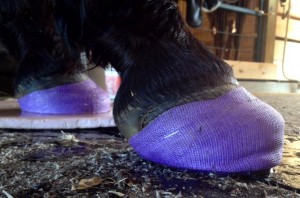
Preventive treatments cryotherapy and supporting at-risk hoofs with packing and casting are featured in an article about laminitis in the ‘Daily Racing Form’:
Vets Gain Ground against Disease Suffered by Paynter and Barbaro
“Veterinarians don’t just look to the foot when tackling laminitis. They carefully consider the underlying cause and then try to stabilize that cause, Orsini said. And today, they are applying therapies aggressively to at-risk horses, not just to those showing acute signs of laminitis, said Dr. Bryan Fraley, a farrier and veterinarian whose Fraley Equine Podiatry is affiliated with Hagyard Equine Medical Institute in Kentucky.
Treat the Laminitis Trigger
“We understand the disease much better now than we did even five or 10 years ago,†said Dr. James Orsini, director of Penn’s Laminitis Institute. “A ‘shock organ’ is an organ that fails related to some sort of systemic disease. In people, the lung is one of those organs. What we’re finding is that the lamellar tissue in the horse’s foot is a similar target organ for the horse. So, we know that if we can treat these other diseases more effectively — like colitis, or a mare with a retained placenta, or a horse with pleural pneumonia — we can better protect the foot from becoming the shock organ that ultimately fails and results in a crippling disease.
Help At-risk Hoofs before Symptoms Appear
“In my experience, if we apply foot casts with impression material like dental impression material to the bottom of the foot, we give those horses very good support to the center of the bony column,†Fraley said. “We try to unload the wall and the laminae…
“We have a lot better technologies in terms of the types of glue-ons and shoes that are out there,†Fraley said. “We have options, from new polyurethane shoes to better support materials. I think farriers are critically important in the treatment of a laminitic horse. Farriers are usually first on the scene and first to recognize the problem. They often recognize subtle changes, and in acute cases, they can get shoes off quickly, with minimal trauma, and help veterinarians get that horse better foot support. 
“The other thing that’s helped is we now understand that a technique that’s been around for hundreds of years — using cold therapy — is one of the best techniques available to us. We can identify the at-risk horse better, and our goal is to prevent the disease rather than have to treat it.â€
